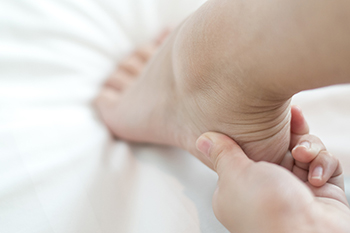March 2022
What Causes Pain in the Front of the Ankle?
 When you flex your foot and the front of your ankle hurts, it may be the result of scar tissue that has built up following a previous injury. This is not unusual after twisting or spraining an ankle, because the torn ligament forms a large mass while healing and then becomes inflamed. That tissue can get caught between the leg (tibial and fibula) and ankle bones, a condition known as anterolateral impingement (ALI), which is common in the aftermath of a high ankle sprain and can be quite painful. Treatment options include icing the ankle, ceasing any activity that aggravates the condition, and wearing a brace to help restrict movement. If those measures fail to relieve the symptoms, however, arthroscopic surgery may be the only recourse. A consultation with a podiatrist is suggested to determine the cause and severity of the condition, and to determine the proper treatment for you.
When you flex your foot and the front of your ankle hurts, it may be the result of scar tissue that has built up following a previous injury. This is not unusual after twisting or spraining an ankle, because the torn ligament forms a large mass while healing and then becomes inflamed. That tissue can get caught between the leg (tibial and fibula) and ankle bones, a condition known as anterolateral impingement (ALI), which is common in the aftermath of a high ankle sprain and can be quite painful. Treatment options include icing the ankle, ceasing any activity that aggravates the condition, and wearing a brace to help restrict movement. If those measures fail to relieve the symptoms, however, arthroscopic surgery may be the only recourse. A consultation with a podiatrist is suggested to determine the cause and severity of the condition, and to determine the proper treatment for you.
Ankle pain can have many different causes and the pain may potentially be serious. If you have ankle pain, consult with Dr. Robert Graser from Graser Podiatry and Bunion Surgery Institute. Our doctor will assess your condition and provide you with quality foot and ankle treatment.
Ankle pain is any condition that causes pain in the ankle. Due to the fact that the ankle consists of tendons, muscles, bones, and ligaments, ankle pain can come from a number of different conditions.
Causes
The most common causes of ankle pain include:
- Types of arthritis (rheumatoid, osteoarthritis, and gout)
- Ankle sprains
- Broken ankles
- Achilles tendinitis
- Achilles tendon rupture
- Stress fractures
- Tarsal tunnel syndrome
- Plantar fasciitis
Symptoms
Symptoms of ankle injury vary based upon the condition. Pain may include general pain and discomfort, swelling, aching, redness, bruising, burning or stabbing sensations, and/or loss of sensation.
Diagnosis
Due to the wide variety of potential causes of ankle pain, podiatrists will utilize a number of different methods to properly diagnose ankle pain. This can include asking for personal and family medical histories and of any recent injuries. Further diagnosis may include sensation tests, a physical examination, and potentially x-rays or other imaging tests.
Treatment
Just as the range of causes varies widely, so do treatments. Some more common treatments are rest, ice packs, keeping pressure off the foot, orthotics and braces, medication for inflammation and pain, and surgery.
If you have any questions, please feel free to contact our office located in Boerne, . We offer the newest diagnostic and treatment technologies for all your foot care needs.
Various Possible Causes of Pain in Your Child’s Feet
There are several reasons why your child may be having heel pain or tenderness at the back of their foot. Sever’s disease is a condition in which a child’s Achilles tendon pulls on and aggravates the growth plate at the back of the heel bone. In Achilles tendonitis, a sudden increase in activity can damage the Achilles tendon, causing pain, warmth, inflammation, and difficulty in walking. Plantar fasciitis is a very common form of heel pain. This condition is an inflammation of the plantar fascia tissue on the sole of the foot, which connects the heel to the toes. If your child has fallen or had an acute injury to the heel, they may have fractured the heel bone. No matter what the cause of your child’s heel pain is, a podiatrist can diagnose it and devise an appropriate treatment plan. If your child is limping or walking on their toes, or complains about pain in their heel or tenderness at the back of their feet, make an appointment for them with a podiatrist.
Making sure that your children maintain good foot health is very important as they grow. If you have any questions, contact Dr. Robert Graser of Graser Podiatry and Bunion Surgery Institute. Our doctor can provide the care you need to keep you pain-free and on your feet.
Keeping Children's Feet Healthy
Having healthy feet during childhood can help prevent medical problems later in life, namely in the back and legs. As children grow, their feet require different types of care. Here are some things to consider...
Although babies do not walk yet, it is still very important to take care of their feet.
Avoid putting tight shoes or socks on his or her feet.
Allow the baby to stretch and kick his or her feet to feel comfortable.
As a toddler, kids are now on the move and begin to develop differently. At this age, toddlers are getting a feel for walking, so don’t be alarmed if your toddler is unsteady or ‘walks funny’.
As your child gets older, it is important to teach them how to take care of their feet.
Show them proper hygiene to prevent infections such as fungus.
Be watchful for any pain or injury.
Have all injuries checked by a doctor as soon as possible.
Comfortable, protective shoes should always be worn, especially at play.
If you have any questions please feel free to contact our office located in Boerne, . We offer the newest diagnostic and treatment technologies for all your foot and ankle needs.
Dealing With Blisters on the Feet
A blister is a sac of fluid that develops in the upper layer of your skin when a body part, typically a toe, rubs against a hard surface like the side or top of a shoe. This is the body’s way of protecting the toe from injury. While most blisters are clear, if one becomes infected it may fill with blood or a yellowish-green pus. Generally, a blister will heal itself in a few days, especially if the activity that caused it is stopped. For instance, if you are walking for long periods in hard leather shoes, and a blister develops, it’s a good idea to change to a more open type of shoe. It's never wise to pop a blister, as that can leave you open to serious infection. If it bursts on its own, avoid removing the dead skin, but gently wrap the area in sterile gauze until it heals. Any time a blister becomes extremely painful or appears to be infected, it is important to consult a podiatrist as soon as possible for appropriate treatment options.
Blisters are prone to making everyday activities extremely uncomfortable. If your feet are hurting, contact Dr. Robert Graser of Graser Podiatry and Bunion Surgery Institute. Our doctor can provide the care you need to keep you pain-free and on your feet.
Foot Blisters
Foot blisters develop as a result of constantly wearing tight or ill-fitting footwear. This happens due to the constant rubbing from the shoe, which can often lead to pain.
What Are Foot Blisters?
A foot blister is a small fluid-filled pocket that forms on the upper-most layer of the skin. Blisters are filled with clear fluid and can lead to blood drainage or pus if the area becomes infected.
How Do Blisters Form?
Blisters on the feet are often the result of constant friction of skin and material, usually by shoe rubbing. Walking in sandals, boots, or shoes that don’t fit properly for long periods of time can result in a blister. Having consistent foot moisture and humidity can easily lead to blister formation.
Prevention & Treatment
It is important to properly care for the affected area in order to prevent infection and ease the pain. Do not lance the blister and use a Band-Aid to provide pain relief. Also, be sure to keep your feet dry and wear proper fitting shoes. If you see blood or pus in a blister, seek assistance from a podiatrist.
If you have any questions, please feel free to contact our office located in Boerne, . We offer the newest diagnostic and treatment technologies for all your foot care needs.
Why Your Heel May Be In Pain
Your feet take a pounding every day, and thankfully, the strong band of connective tissue on the sole of the feet (plantar fascia) is there to absorb a lot of this stress. However, the plantar fascia can eventually become overly stressed or damaged, and even suffer micro-tears where it attaches to the heel. This condition, known as plantar fasciitis, causes inflammation in the tissue and a great deal of heel pain. This pain may come on gradually and is usually at its worst first thing in the morning or after periods of rest. Once you start moving around the pain typically subsides, but eventually returns as the day progresses. What causes the plantar fascia to become damaged? There are many possible factors that can lead to plantar fasciitis such as: obesity, age, ill-fitting or non-supportive footwear, standing for long periods of time, excessive strain during exercise, tight Achilles’ tendons or calf muscles, running on hard surfaces, and certain foot disorders like flat feet or high arches. There are a variety of treatments that a podiatrist can administer to relieve the pain and reduced mobility associated with plantar fasciitis. If you have heel pain, it is suggested that you make an appointment with a podiatrist.
Plantar fasciitis is a common foot condition that is often caused by a strain injury. If you are experiencing heel pain or symptoms of plantar fasciitis, contact Dr. Robert Graser from Graser Podiatry and Bunion Surgery Institute. Our doctor can provide the care you need to keep you pain-free and on your feet.
What Is Plantar Fasciitis?
Plantar fasciitis is one of the most common causes of heel pain. The plantar fascia is a ligament that connects your heel to the front of your foot. When this ligament becomes inflamed, plantar fasciitis is the result. If you have plantar fasciitis you will have a stabbing pain that usually occurs with your first steps in the morning. As the day progresses and you walk around more, this pain will start to disappear, but it will return after long periods of standing or sitting.
What Causes Plantar Fasciitis?
- Excessive running
- Having high arches in your feet
- Other foot issues such as flat feet
- Pregnancy (due to the sudden weight gain)
- Being on your feet very often
There are some risk factors that may make you more likely to develop plantar fasciitis compared to others. The condition most commonly affects adults between the ages of 40 and 60. It also tends to affect people who are obese because the extra pounds result in extra stress being placed on the plantar fascia.
Prevention
- Take good care of your feet – Wear shoes that have good arch support and heel cushioning.
- Maintain a healthy weight
- If you are a runner, alternate running with other sports that won’t cause heel pain
There are a variety of treatment options available for plantar fasciitis along with the pain that accompanies it. Additionally, physical therapy is a very important component in the treatment process. It is important that you meet with your podiatrist to determine which treatment option is best for you.
If you have any questions, please feel free to contact our office located in Boerne, . We offer the newest diagnostic and treatment technologies for all your foot care needs.
When Is Toenail Surgery an Option?
Many rheumatoid arthritis sufferers find that ingrown toenails have become an ongoing problem. An ingrown toenail occurs when the outer edge of the nail gets embedded in the surrounding skin. This can cause pain, swelling, and possibly an infection. If this happens regularly, surgery to remove the nail may be an option to consider. If you still have a good blood supply to the feet and toes, and if you are not currently having a rheumatoid flare-up, removal of the toenail is a viable option. Surgery, which can be carried out by a podiatrist, is a long-term solution. But it’s important to remember that because of rheumatoid arthritis the healing process may be slow. Other options can include changing your footwear to a larger size and seeing a podiatrist to set up a series of regular foot-care appointments as a preventative measure.
Ingrown toenails can become painful if they are not treated properly. For more information about ingrown toenails, contact Dr. Robert Graser of Graser Podiatry and Bunion Surgery Institute. Our doctor can provide the care you need to keep you pain-free and on your feet.
Ingrown Toenails
Ingrown toenails occur when a toenail grows sideways into the bed of the nail, causing pain, swelling, and possibly infection.
Causes
- Bacterial infections
- Improper nail cutting such as cutting it too short or not straight across
- Trauma to the toe, such as stubbing, which causes the nail to grow back irregularly
- Ill-fitting shoes that bunch the toes too close together
- Genetic predisposition
Prevention
Because ingrown toenails are not something found outside of shoe-wearing cultures, going barefoot as often as possible will decrease the likeliness of developing ingrown toenails. Wearing proper fitting shoes and using proper cutting techniques will also help decrease your risk of developing ingrown toenails.
Treatment
Ingrown toenails are a very treatable foot condition. In minor cases, soaking the affected area in salt or antibacterial soaps will not only help with the ingrown nail itself, but also help prevent any infections from occurring. In more severe cases, surgery is an option. In either case, speaking to your podiatrist about this condition will help you get a better understanding of specific treatment options that are right for you.
If you have any questions please feel free to contact our office located in Boerne, . We offer the newest diagnostic and treatment technologies for all your foot and ankle needs.
Blog Archives
- July 2024
- June 2024
- May 2024
- April 2024
- March 2024
- February 2024
- January 2024
- December 2023
- November 2023
- October 2023
- September 2023
- August 2023
- July 2023
- June 2023
- May 2023
- April 2023
- March 2023
- February 2023
- January 2023
- December 2022
- November 2022
- October 2022
- September 2022
- August 2022
- July 2022
- June 2022
- May 2022
- April 2022
- March 2022
- February 2022
- January 2022
- December 2021
- November 2021
- October 2021
- September 2021
- August 2021
- July 2021
- June 2021
- May 2021
- April 2021
- March 2021
- February 2021
- January 2021
- December 2020
- November 2020
- October 2020
- September 2020
- August 2020
- July 2020
- June 2020
- May 2020
- April 2020
- March 2020
- February 2020
- January 2020
- December 2019
- November 2019
- October 2019
- September 2019
- August 2019
- July 2019
- June 2019
- May 2019
- April 2019
- March 2019
- February 2019
- January 2019
- December 2018
- November 2018
- October 2018
- September 2018
- August 2018
- July 2018
- June 2018
- May 2018













